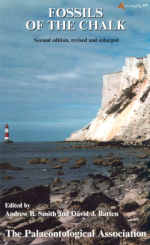Добрый день, Коллеги. Важное сообщение, просьба принять участие. Музей Ферсмана ищет помощь для реставрационных работ в помещении. Подробности по ссылке
Fossils of the Chalk / Ископаемые мела
The characteristic white limestones that form the Chalk were deposited across much of northern Europe during the Upper Cretaceous, 100 to 65 million years ago. Although the Chalk is not normally rich in fossils, the preservation is often exquisite and specimens are relatively easy to prepare out from the matrix using needles and brushes or an air abrasive. This explains why the Chalk has been, and continues to be, a favourite formation of many fossil collectors. The extensive collections housed in museums are the result of persistent collecting over more than 150 years, though few were collected with the necessary detailed stratigraphical horizoning that is so essential to today's study of the Chalk fauna.
This book is aimed at the amateur fossil collector and sets out to provide a pocket field guide to the range of macrofossils found in the Chalk of Britain. It covers most of the important groups that are likely to be encountered in field collecting, with the exception of serpulid worms and corals which unfortunately could not be covered (neither group is either diverse or important in the Chalk). It must be emphasized that the fossils illustrated here are only a small selection of the total fauna likely to be found in the Chalk, though authors have tried to include all of the common species and genera. In some cases more detailed and comprehen-sive monographs on particular groups have been published and the more important works are generally listed at the start of each chapter. In other cases the primary systematic work has yet to be done and no such publications exist.
Almost 400 Chalk fossils are illustrated, most of which are housed in the British Museum (Natural History). For each entry there is a brief description to aid identification, together with the stratigraphical range of the species. In addition, where similar species exist that might be con-fused, but which have not been illustrated, these are sometimes compared and contrasted in the text. It is beyond the scope of this book to deal comprehensively with the terminology applied to the fossilized hard parts of so many different groups and a reasonable background knowledge has had to be assumed of the reader. Nor is it possible to discuss the taxonomic framework that each author has adopted. Any standard palaeontological text-book, or the Treatise on invertebrate paleontology ought to be consulted on these matters.
Probably more than for any other stratigraphical formation, amateurs have played a major role in furthering our understanding of the Chalk faunas and their distribution. Notable amateurs include the Reverend Thomas Wiltshire, J. Starkie Gardner, Henry Willett A W Rowe R M Brydone, C. T. A. Gaster and E. V. and C. W Wright Without their diligence our knowledge of the Chalk fauna would be very much the poorer. I sincerely hope that future generations of amateurs will continue this tradition and that this book will provide encouragement to their pursuit.




